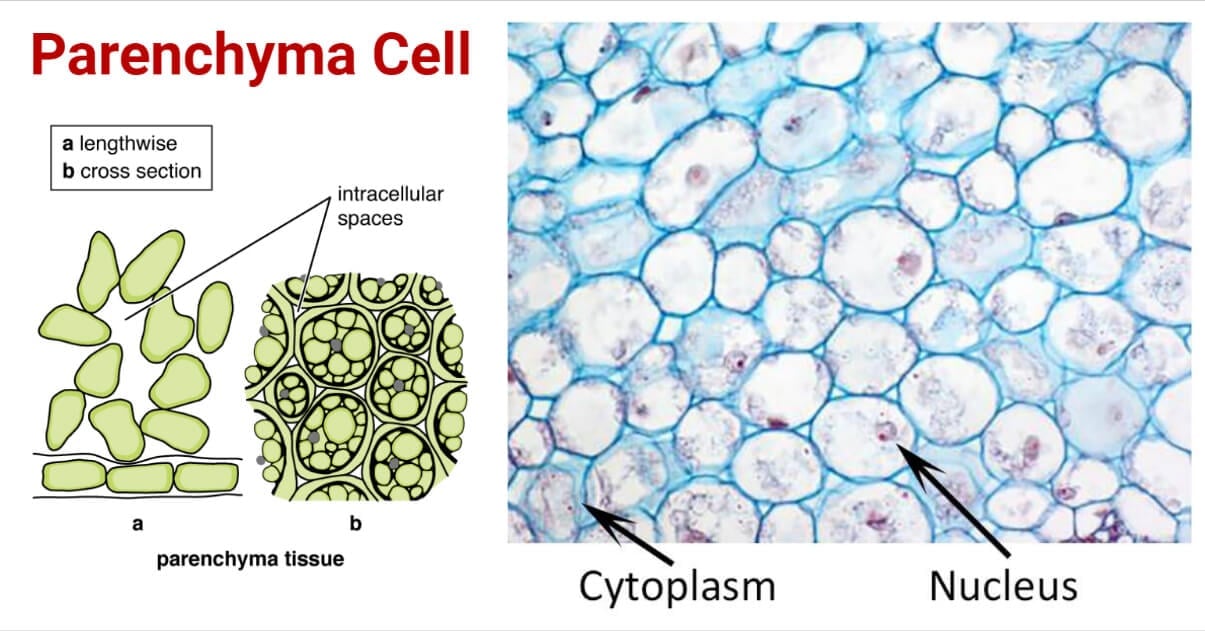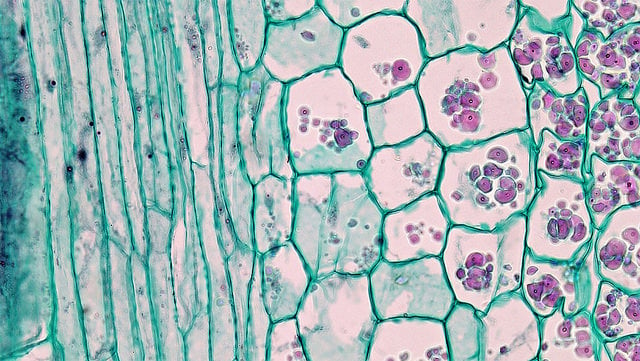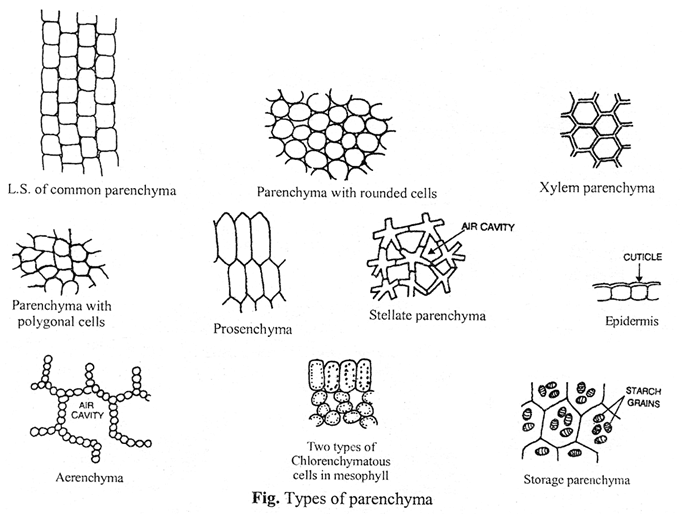Parenchyma is a type of simple permanent tissue composed of a living cell that helps to form the ground or fundamental tissue in a plant together with collenchyma and sclerenchyma. Ground tissue is not vascular tissue or part of the dermis of the plant.

The term “parenchyma” is derived from the Greek word “Para” and “Enchyma”. Para means besides, and Enchyma means inclusion. It is a type of tissue that consists of cells that carry out an essential function.
Interesting Science Videos
What are Parenchyma Cells?
- Parenchyma cells are simple living cells that have thin cell walled and unspecialized cells; because of their unique nature, these are adaptable for different functions.
- The cells are present in different places all over plant bodies and help in plant survival, photosynthesis, secretion, food storage, assimilation, extraction, respiration, transportation of water throughout the body, and other function of plant life.
- Parenchyma cells are the foundation of a plant as reproductive cells (spore, gametes) are parenchymatous.
- Parenchyma cells are distributed in the pith and cortex reason of stem and root, mesophyll cells of leaves, the flesh of succulent roots, the endosperm of seed, etc in the plant.
- Like, the endosperm tissue of seed, parenchyma cells are rigidly intact with each other without any intracellular space on maturity.
- Some parenchymal cells comprise a more intracellular space by having loosely arranged neighbor cells. Example: leaves and stem of the hydrophilic plants.
Structure of Parenchyma Cell

- The shape of each parenchyma cell is different such as polyhedral, stellate, elongate, lobed, circular, and isodiametric, based on the exact location and their function.
- These cells consist of thin cell walls which are composed of cellulose, hemicellulose, and calcium pectate. They are closely packed, and the intracellular space of parenchyma is small.
- This ground cell consists of prominent protoplast and nuclei.
- Parenchyma contains a central vacuole; because of this reason, its size is larger. Water and ions are stored by vacuoles.
- These cells have multiple small vacuoles, which are fused and form a large central vacuole in mature parenchyma.
- In general, parenchyma cells contain chloroplast (which perform photosynthesis), ribosome, endoplasmic reticulum, Golgi body, and plasmodesmata. These cells help in performing the secretory function.
- Plasmodesmata act as a linkage between the cells of the parenchyma tissue.
- Parenchyma may have a thick cell wall in some plants. For example endosperm of date palm, the sugar becomes the nutrients for germinating embryos, sugar is present in these thick walls.
Types of Parenchyma Cell
Parenchymal cells are classified into 7 types based on function.
- Chlorenchyma:
- Chlorenchyma is usually present in the mesophyll tissue of the leaves.
- It is a parenchymatous cell with chloroplasts.
- Additionally, they are also present in the outer cortex of the stem of the young plant.
- These cells are generally loosely packed with multiple intracellular spaces.
- The stem and the aerial root of the plants are green due to the presence of chlorenchyma cells. It helps in photosynthesis.
- Aerenchyma:
- Aerenchyma is present in aquatic plants, and its function is to provide buoyancy to the plant.
- These cells are loosely packed with plenty of intracellular space as larger air cavities.
- The aerenchyma naturally forms in the root of rice.
- It helps in the diffusion of air from leaves to the roots as it is present continuously from shoots to roots and helps in maintaining sufficient oxygen levels for respiration.
- In case excess oxygen is consumed, it diffuses out from roots to the soil atmosphere and creates an aerobic rhizosphere in anaerobic soil.
- These cells store respiratory gases (oxygen and carbon dioxide), which can be utilized by the plants when required.
- Prosenchyma:
- Prosenchyma cells are present in the vascular tissue of the plant,
- These cells characteristically elongate, and narrow-sized parenchyma possess interpenetrating tapering(pointed) ends.
- Vascular parenchyma:
- Vascular parenchyma provides nutrients to the vascular tissue where it is present.
- Some parenchymal cells store ergastic substances (resins, tannins). Example: axial and ray parenchyma, which are present in wood, form tylose in the heartwood. Tylose blocks the xylem cavity, thereby preventing water transportation through them.
Vascular parenchyma is of two types.
a. Phloem parenchyma:
- It contains cylindrical, elongate, and tapering cells with dense cytoplasm.
- In monocotyledons, phloem parenchyma is absent.
- It stores food and other material such as resins, mucilage, and latex.
b. Xylene parenchyma:
- Its cell wall is thin and made up of cellulose.
- In water stress conditions, it prevents vessels and tracheids from being damaged.
- Radial transportation of minerals and water takes place via ray parenchymatous cells.
- Medullary parenchyma:
- The medullary parenchyma is present in the medullary ray of primary vascular tissue.
- These cells are radially elongated with very thin-walled cells.
- These cells allow radial distribution of water and mineral to the plant
- It helps in the storage of starch grains.
- Conjunctive parenchyma:
- Conjunctive parenchyma makes the conjunctive tissue of the stele of roots.
- In monocots, conjunctive tissue becomes sclerenchyma when mature.
- It is present in the root system made tubular outgrowth called root hair. It helps to absorb minerals and water from the soil.
- Armed parenchyma:
- These cells are present in the mesophyll part of gymnosperm, and they lokes like star-shaped.

On the basis of shape, Parenchyma cells are classified into two types:-
- Angular parenchyma:
- Its shape is polygonal with angular ends.
- That is completely packed without intracellular space.
- Circular parenchyma:
- These cells are structurally circular in outline.
- These are loosely packed with more intracellular space.
Functions of Parenchyma Cell
- The primary function of the parenchymal cell is to store food materials (i,e, starch, hormone, protein, fat, nutrients, etc) and water through a large central vacuole.
- Parenchymal cells make the ground tissue (apart from vascular and dermal tissue) of the plant.
- The nature of the parenchyma cell is meristematic (the ability to divide into many different cells). It plays a vital role in healing and repairing wounds.
- Besides food materials, it also stores waste products of plants as well as ergastic substances.
- Chloroplast present in all green parts of a plant with Chlorenchyma performs photosynthesis.
- Participate in forming structure to thebe plant by giving a mechanical rigidity to it.
- The various metabolic pathway (synthesis of food materials, energy for plant development and growth) takes place in parenchyma cell.
- Aerenchyma cells facilitate buoyancy in some aquatic plants.
- These cells help in the transportation of nutrients, ions, chemicals, and water all over the plant body.
- Central vacuoles present in parenchyma cells accumulate anthocyanin and tannin.
- Gymnosperm parenchymatous cells contain spiny projections that protect them from predator attacks.
- The xylem parenchyma plays important role in the radial conduction of minerals and water. Some cells pass light from the surface to underground cells.
References
- https://biologyreader.com/parenchyma-in-plants.html.
- https://byjus.com/neet/parenchymacells/
- https://www.britannica.com/science/parenchyma-plant-tissue.
- https://www.biologyonline.com/dictionary/parenchyma.
- https://www.bioexplorer.net/parenchyma-cells.html/
- https://www.vedantu.com/neet/parenchyma-cells.
- https://biologydictionary.net/parenchyma-cells/
